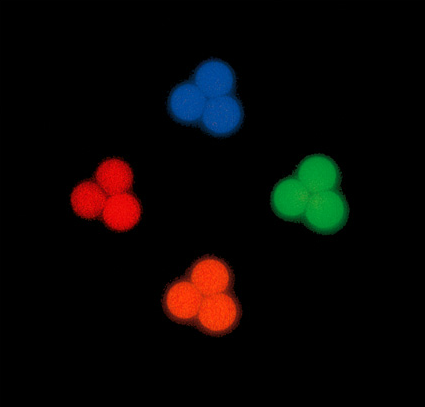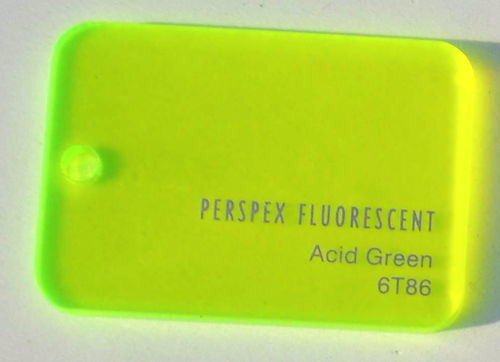Test slides

Let me tell you a little story.
The place is the CONFOCALMICROSCOPY listserv.
The time is 1997.
A query asks how to mount fluorescent beads from Molecular Probes in order to image them without a refractive index mismatch problem. A helpful response informed:
The real deal is that all ‘scope manufacturers assume a couple of things.
1. The refractive index of the immersion oil is 1.515 ( be aware RI changes
w/ temp)2. The cover slip is .17 microns #1 1/2
3. The subject is the back ( side away from the objective) of the coverslip.
4. The immersion media of the subject is normally water ( some mfgs. choose
other RI’s.
Fastforward to 2005.
Molecular Probes (MP aka Invitrogen) posts to the listserv to advertise their new FocalCheck products, which are fluorescent beads pre-mounted on slides.
This was the swift response from the listserv community:
Why are the beads not mounted with a 1.5 coverslip (0.17mm)? Microscopes are designed for that thickness and there will be significant spherical aberration with a #1 coverslip (especially with a high dry objective).
Fastforward again to 2010.
A query complains of not being able to focus on the beads in a FocalCheck slide from Molecular Probes.
They have sent me another one and I’m having the same trouble focusing.
A Molecular Probes rep suggests that the user buy the beads and mount them to a coverslip themselves:
You may want to consider buying and mounting the desired stand alone beads directly onto a coverslip for the immediate future (cheaper than a new objective!).
You know what else is cheaper than a new objective? Properly manufactured FocalCheck slides.
At this point, Paul Herzmark pitched in:
Invitrogen has known that they make their bead test slides wrong since at least July 2005. I copy below an email exchange I had with the company.
The original poster doubted that the coverslip thickness was the problem. Guy Cox chimed in:
No, no, it IS the problem! As Mike Ignatius explained, MP put the beads on the slide, not the coverslip, then add mountant and then the coverslip. If you are using a #1.5 coverslip you need to put the beads directly on the coverslip. With the beads on the slide the extra thickness of the mountant needs to be corrected for by using a thinner coverslip – #1 or #0 – which must be found by trial and error.
A flurry of comments came in, including this one:
They sell these “test slides” for hundreds of dollars, yet they don’t take the time to make them right?!?! They should be made with correct coverslips chosen for their thickness, deposited on them and then mounted on the glass slide… I see that there is a disconnect some where, how much does it cost them to produce these slides? 10 bucks maybe…
Fastforward to now. Molecular Probes happily reports that they now make the test slides correctly.
We are pleased to announce that we were able to improve the mounted TetraSpeck beads products described in this colorful email string from over a year ago (with some comments extending back to 2005).
TetraSpeck beads are now mounted on the #1.5 coverslips, not the slides.
It took some doing – overspray from the mask used to find the bead focal plane was our biggest unanticipated issue that delayed this so much. Many apologies to anyone out there that remained on backorder. But the product, T14792 and other bead mounted slides, like our intensity and size bead series, F36909, are now on the coverslip.
Great!
(BTW, I corrected their spelling of “TetraSpeck”, which apparently is the current marketing incarnation of FocalCheck.)
In addition to beads, there are a couple of other test slides I like to have handy.
Fluorescent plastic slides
These are handy for alignment. They also give a great impression of uniformity over the field of view.
We got a kit from Chroma a long time ago. I’m not sure if they still sell them, but any fluorescent plastic will work, so you can make your own. Perhaps engineering samples from a company (for example), or repurposing a bit of found fluorescent plastic.

Biological sample slides
Mixed pollen grains are a favorite (example source), but really, any sample will do. Something with some high resolution features.

Chroma does have autofluorescent slides available. They can be ordered from the website or requested at any of the many meetings we attend. (SFN, ASCB, PW, PITTCON, etc).
Ted Pella also has test slides of solid fluorescent plastic. A set of 4 is ~$30:
https://www.tedpella.com/calibration_html/Light-Microscopy-Calibration-Standards.htm#fluorescence
Ted Pella is a distributor. The slides I ordered from them are are Chroma slides with a Ted Pella label on top
A student in the lab went to the flower shop and bought a random bouquet of flowers. We took a small sample of pollen, dissolved it in agar, sonicated it and mounted it on a slide or in block. We got a nice test sample of pollen and his girlfriend got the flowers. Everyone was happy. I think nearly all flower pollen is fluorescent in both red and green channels.